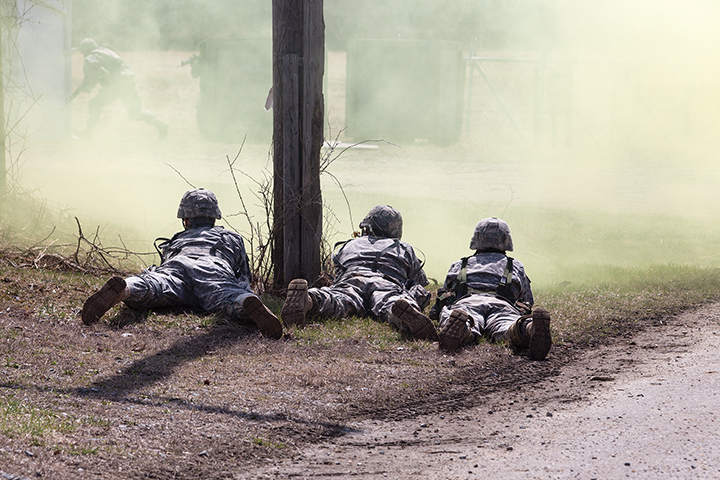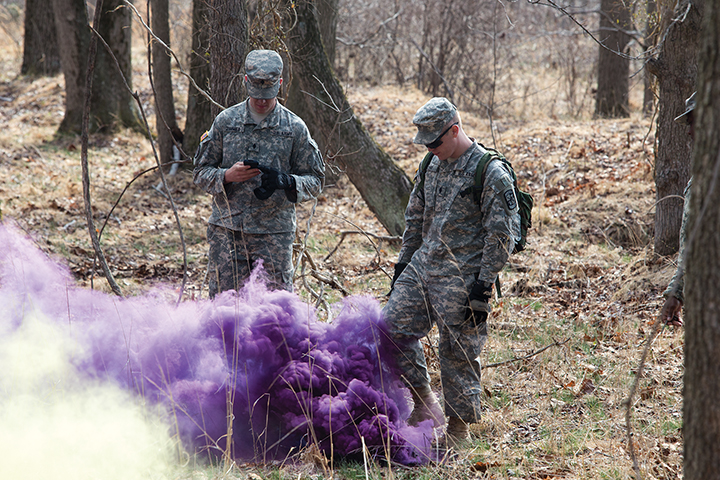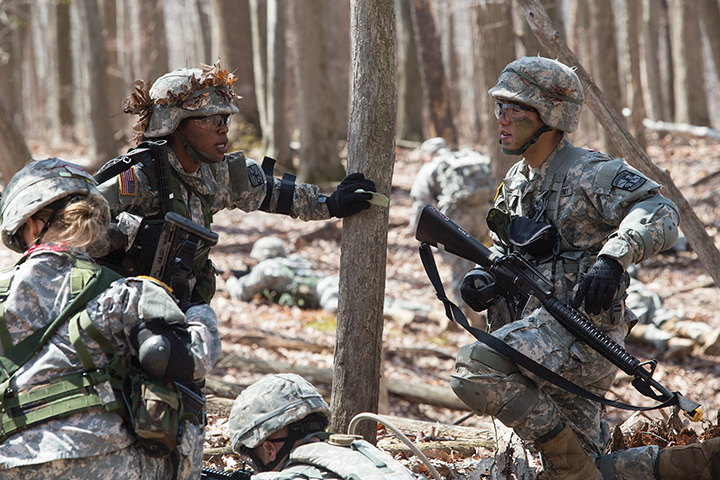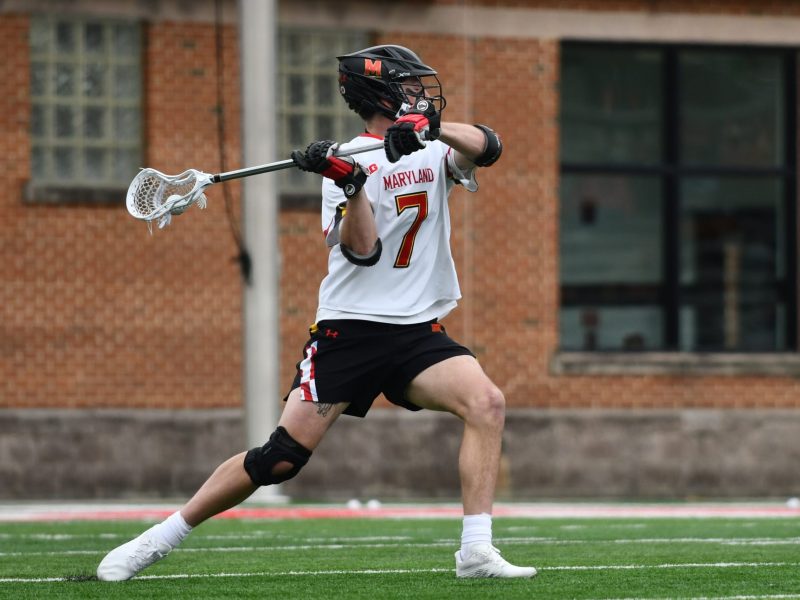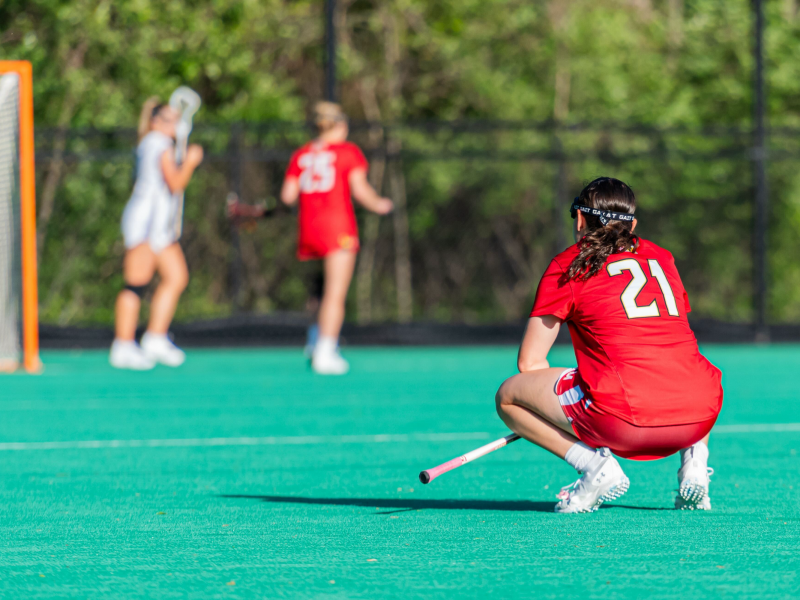EDGEWOOD — A platoon of Army ROTC cadets from this university and several other local schools talked tactics as they prepared for a raid operation 700 meters from their assembly area in the woods.
A high-value target was holed up in old World War II barracks, not far from the edge of the dense woods where the platoon began planning for the raid. The objective: Locate the high-value target, restrict his movement, then capture or kill him.
This platoon wasn’t carrying out an actual raid operation or moving on a high-value target in the same way the Army moved in to capture Saddam Hussein or similar operations — they were participating in a simulation. They hoped to demonstrate their leadership skills and abilities, which were being evaluated by senior cadets, active-duty military personnel and contractors.
The raid was part of a large schedule of physically taxing exercises for area ROTC programs, including those at Johns Hopkins University, McDaniel College, University of Delaware, Loyola University Maryland, Morgan State University and this university. The Joint Field Training Exercise is a three-day test of leadership for junior class cadets from universities across the state.

ROTC Joint Field Training Exercise
They arrived at Lauderick Creek Training Site near Aberdeen Proving Ground on Thursday, preparing for a rigorous early-morning physical training test of push-ups, sit-ups and a two-mile run on Friday. They then participated in tactics training until noon, and the afternoon was filled with a point-to-point land navigation exercise.
By the time the platoon members were planning for Saturday’s afternoon raid, they were working off little sleep and more than 12 straight hours of training the previous day. However, Capt. Peter Farese said the cadets didn’t seem worn out by the training.
“What we tried to do was push them to a limit where they were operating off of minimal sleep,” Farese said. “What we didn’t see from our cadets here at the university was them breaking stride at all.”
On Saturday, the platoon split into three squads. Each had a squad leaderin charge of two teams, an Alpha and a Bravo team, each of which was under the command of a team leader. In a raid, each squad needs to have an assault element, which is responsible for initiating the raid and is the first to move on the enemy; a support element, which provides cover fire for the assault team; and a security element, which secures an area and seals off any enemy movement.
Josef Danczuk, a junior government and politics and history major, was a team leader for the assault element and was confident in his team’s ability an hour before the platoon made its final movements on the objective.
“It’s very fast-paced. I think we’ve got a great squad here,” Danczuk said. “It’s tough because we’re basically running right at the enemy, and so there’s a good chance we’ll sustain casualties. We have to be able to be ready to get our aid and litter teams, basically our medics, up there to take care of them.”
The platoon began its march toward a small building in a field just outside the woods. Squad and platoon leaders were under the watchful eyes of their evaluators who stood by with blue evaluation forms, ready to judge each cadet on character, presence, intellect and more.
The first test for the platoon came at a break in the woods, where it no longer had the cover of tall trees and was thoroughly exposed to anyone on the outside, in what is called a linear danger area.

ROTC Joint Field Training Exercise
The platoon moved across a small clearing, massing their leading cadets at the edge of the woods, while a small brigade in the back pushed through. The cadets on the woodline secured the trail, then followed in the rear across the clearing.
These decisions — identifying a linear danger area and coordinating their movements — are factored into cadet leadership evaluations.
As the platoon moved closer on the objective and approached the high-value target, cadets set up a 360-degree security perimeter as other cadets planned reconnaissance. A reconnaissance team assembled and began to move a small team of cadets forward to ensure the objective was carried out as they planned.
Not long after the reconnaissance team moved on the target, the enemy — senior cadet volunteers — spotted the platoon and began firing from a small building nearby. The quiet march turned into a volley of rifle blanks and fast-paced movements from the platoon and a barrage of small-arms fire from the enemy.
The two sides exchanged fire while the assault team moved in on the barracks housing the high-value target. The team pushed out of the woods and dropped into the tall grass just outside the building as it sustained its fire on the enemy.
An interruption to the chain of command forced smaller squads and their teams to fall back and wait for orders. Despite the slight alteration to plans, the platoon was able to move on the building, take out the enemy forces and complete the training’s mission of killing the high-value target.
The unexpected interruption slowed down the objective. But evaluators weren’t interested in exactly how the raid was pulled off; they wanted to see how leaders were able to adapt to the interruptions and the unexpected variables that cropped up during the field exercise. One squad leader — Angelica Bonnett, a junior sociology major at Bowie State University and a cadet enrolled in this university’s ROTC program — said the operation was ultimately successful because of good communication among the teams.
“There were clear channels of communication, so whenever there were changes throughout the operation, everybody was up to speed on the specific tasks that either needed to be done or were already tasked,” Bonnett said.
The raid operation was one of three simulated training exercises the platoon did Saturday. Over the course of these exercises, evaluators used 19 leadership metrics that include military and professional bearing, confidence, resilience and more. Leaders earned a final grade of “E” (Excellent), “S” (Satisfactory) or “N” (Needs Improvement).
“Cadets aren’t specifically graded on their ability to conduct a raid,” said Andrew Frazier, a senior mechanical engineering major at Johns Hopkins and battalion commander for its ROTC program. “What the evaluators are looking for is how the cadets in charge conduct themselves.”
Farese was pleased with the outcome of the weekend exercises. About 41 percent of this university’s battalion of 31 cadets earned “E” scores. The average for a school, Farese said, is about 10 to 15 percent “E” ratings.
“I thought they did well,” Farese said. “I was very happy with their accomplishments this past weekend.”

ROTC Joint Field Training Exercise
The Joint Field Training Exercise is an opportunity to assess junior class ROTC students and prepare them for a month-long leader development and assessment course in Fort Knox, Ky., that begins in the summer. After this weekend, Farese said he was confident the university’s cadets will be successful in the summer program, which will put the cadets through similar exercises.
The weekend exercise also prepares junior cadets to be second lieutenants in the Army, said Lt. Col. Paul Carroll, a military science professor at Johns Hopkins.
“Being an officer in the Army is an outdoor full-contact sport,” Carroll said. “The five [other] universities here are all very strong programs. They do very well nationally.”
The weekend is also an effective team-building exercise, as platoons are made up cadets from different area schools, not just from one university.
“What they’re trained to do, what they’re taught, what they’re expected to do is to build a team within that squad across universities and build it quickly, and then perform the task they have to perform,” Carroll said. “They form friendships, they’ll stay in contact with social media when they leave here, and they see themselves as a member of that squad even by the end of three days.”
ROTC cadets from local schools and this university practice a raid in Edgewood over the weekend.
